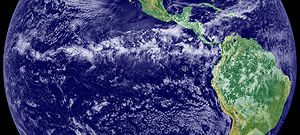AY Honors/Weather - Advanced/Answer Key
The Intertropical Convergence Zone (ITCZ), also known as the Intertropical Front or the Equatorial Convergence Zone, is a belt of low pressure girdling Earth at the equator. It is formed by the vertical ascent of warm, moist air from the latitudes above and below the equator.
The air is drawn into the intertropical convergence zone by the action of the Hadley cell, a macroscale atmospheric feature which is part of the Earth's heat and moisture distribution system. It is transported aloft by the convective activity of thunderstorms; regions in the intertropical convergence zone receive precipitation more than 200 days in a year.
The location of the intertropical convergence zone varies over time, as it moves back and forth across the equator in a semiannual pattern, following the sun's zenith point. There is also a diurnal cycle, with cumulus developing around midday and building to thunderstorms in mid to late afternoon.
Variation in the location of the intertropical convergence zone drastically affects rainfall in many equatorial nations, resulting in the wet and dry seasons of the tropics rather than the cold and warm seasons of higher latitudes. Longer term changes in the intertropical convergence zone can result in severe droughts or flooding in nearby areas.
Within the ITCZ the average winds are slight, unlike the zones north and south of the equator where the trade winds feed in. Early sailors named this belt of calm the doldrums because of the low spirits they found themselves in after days of no wind. To find oneself becalmed in this region in a hot and muggy climate could mean death in the era when wind was the only motive force.
Sometimes, a double ITCZ forms, with one located north and another south of the equator. When this occurs, a narrow ridge of high pressure forms between the two convergence zones, and usually, one or the other of the zones is stronger than the other.
In addition, the movement of the ITCZ affects weather systems north and south of the equator; as the ITCZ moves north the Hadley, Ferrel and Polar cells are "squashed" northwards, resulting in low pressures over latitudes of 15 to 30 degrees, roughly eqauting to the British autumn; characterised by wet and windy weather. As the ITCZ begins to move south again northern latitudes move back onto summer as the dominant high pressure areas re-assert themselves.
References
de:Innertropische Konvergenzzone es:Zona de convergencia intertropical fr:Zone de convergence intertropicale nl:Doldrum no:Den intertropiske konvergenssonen nn:Den intertropiske konvergenssonen pl:Tropikalna strefa konwergencji simple:Doldrums fi:Pasaatituulten kohtaamisvyöhyke sv:Intertropiska konvergenszonen


